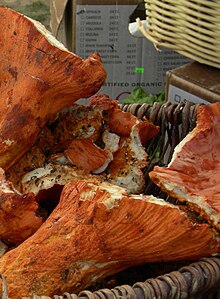Hypomyces lactifluorum: Difference between revisions
Content deleted Content added
Apokryltaros (talk | contribs) Reverted 1 edit by 73.11.46.151 (talk): Then why for the common name of "lobster"? (TW) |
weasel words |
||
| Line 13: | Line 13: | ||
| binomial_authority = ([[Lewis David von Schweinitz|Schwein.]]) [[Louis René Tulasne|Tul.]] & [[Charles Tulasne|C.Tul.]] |
| binomial_authority = ([[Lewis David von Schweinitz|Schwein.]]) [[Louis René Tulasne|Tul.]] & [[Charles Tulasne|C.Tul.]] |
||
}} |
}} |
||
The '''Lobster mushroom''', '''''Hypomyces lactifluorum''''', contrary to its common name, is not a [[mushroom]], but rather a [[Parasite|parasitic]] [[ascomycete]] fungus that grows on certain species of mushrooms, turning them a reddish orange color that resembles the outer shell of a cooked [[lobster]]. ''H. lactifluorum'' specifically attacks members of the genera ''[[Lactarius]]'' and ''[[Lactifluus]]'' (milk-caps), and ''[[Russula]]'' (brittlegills), such as ''[[Russula brevipes]]'' and ''[[Lactifluus piperatus]]'' in [[North America]]. At maturity, ''H. lactifluorum'' thoroughly covers its host, rendering it unidentifiable. Lobster mushrooms are widely eaten and enjoyed; they are commercially marketed and are commonly found<!--Fresh or dried?--> in some large grocery stores.<!--Grocery stores in which nations?--> They have a seafood-like flavor and a firm, dense texture |
The '''Lobster mushroom''', '''''Hypomyces lactifluorum''''', contrary to its common name, is not a [[mushroom]], but rather a [[Parasite|parasitic]] [[ascomycete]] fungus that grows on certain species of mushrooms, turning them a reddish orange color that resembles the outer shell of a cooked [[lobster]]. ''H. lactifluorum'' specifically attacks members of the genera ''[[Lactarius]]'' and ''[[Lactifluus]]'' (milk-caps), and ''[[Russula]]'' (brittlegills), such as ''[[Russula brevipes]]'' and ''[[Lactifluus piperatus]]'' in [[North America]]. At maturity, ''H. lactifluorum'' thoroughly covers its host, rendering it unidentifiable. Lobster mushrooms are widely eaten and enjoyed; they are commercially marketed and are commonly found<!--Fresh or dried?--> in some large grocery stores.<!--Grocery stores in which nations?--> They have a seafood-like flavor and a firm, dense texture. |
||
== External links == |
== External links == |
||
{{commons category|Hypomyces lactifluorum}} |
{{commons category|Hypomyces lactifluorum}} |
||
Revision as of 01:19, 28 April 2016
| Lobster mushroom | |
|---|---|

| |
| Scientific classification | |
| Kingdom: | |
| Division: | |
| Class: | |
| Order: | |
| Family: | |
| Genus: | |
| Species: | H. lactifluorum
|
| Binomial name | |
| Hypomyces lactifluorum | |
The Lobster mushroom, Hypomyces lactifluorum, contrary to its common name, is not a mushroom, but rather a parasitic ascomycete fungus that grows on certain species of mushrooms, turning them a reddish orange color that resembles the outer shell of a cooked lobster. H. lactifluorum specifically attacks members of the genera Lactarius and Lactifluus (milk-caps), and Russula (brittlegills), such as Russula brevipes and Lactifluus piperatus in North America. At maturity, H. lactifluorum thoroughly covers its host, rendering it unidentifiable. Lobster mushrooms are widely eaten and enjoyed; they are commercially marketed and are commonly found in some large grocery stores. They have a seafood-like flavor and a firm, dense texture.
External links
Wikimedia Commons has media related to Hypomyces lactifluorum.
